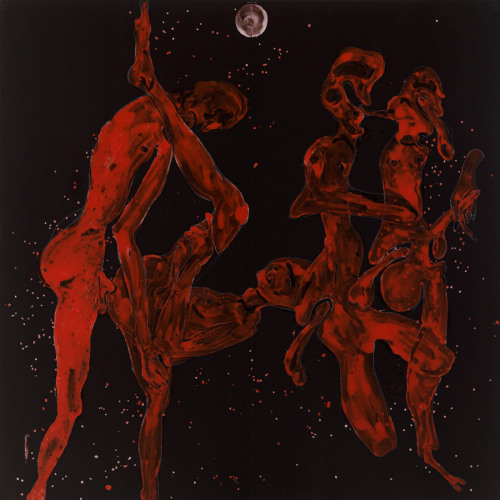
Roger Hiorns, L'important, c'est que le sexe n'ait pas été seulement affaire de sensation et de plaisir, de loi ou d'interdiction, mais aussi de vrai et de faux, 2018, oil pigment and acrylic medium on polyurethane sheet
In a recess in the basement of Berlin’s exhibition and event venue Kraftwerk, three limp figures hang spotlit against the concrete walls. In place of biological organs, their limbs and torsos are stuffed full of pages from Martin Heidegger’s existential philosophy, Being and Time (1927). On the floors above, hundreds of experimental-music fanatics drift, chain-smoking, dressed only in black, absorbing the thundering bass vibrations. For four nights a year, the former East German power station is occupied by Atonal festival, a programme of sonic and visual art. The hanging figures are a work by Roger Hiorns – the artist known for burying aircraft, investigating vCJD (Mad Cow Disease) and exhibiting listless naked young men atop piles of dust pulverized from a stone altar.
Sean Burns met with Hiorns in London to discuss his Atonal installation, The retrospective view of the pathway (2009–2019), and the politics of making work for public institutions.
Sean Burns What was it like working with Atonal?
Roger Hiorns I was trying to understand [visual programmer] Adriano Rosselli’s voice through his choices. I am interested in ambiguity and, in reality, this new work somewhat lacked that in its directness. As soon as Adriano received the piece, he started playing with it in ways I hadn’t anticipated, in ways that queried my usually direct instructions. It’s a simple work: its needs are simply to be introduced to a situation.
SB Yes, there was a certain amount of theatricality in the display.
RH I’m intimately involved with making, of course – obsessively so. Then comes the time for the institution to run with the work. I am not a stylist. I can invest a certain amount of time in ideas of display, but it’s not the highest priority, so I really welcomed the veil of theatricality imposed on the piece. I didn’t recognize the motives behind it and this opened up something, which I appreciated.
View full article at frieze.com

